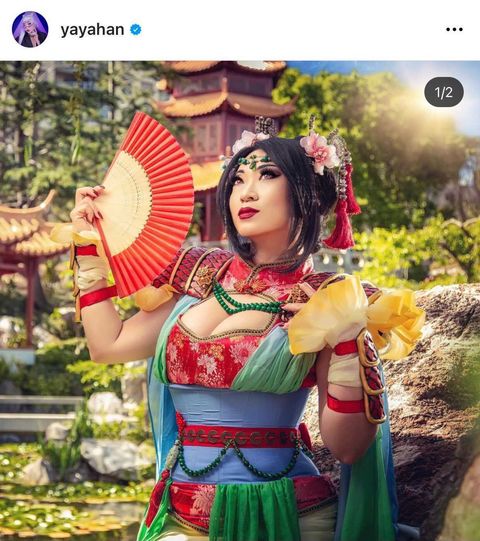Image Attribution: “Cartoons cosplay characters” by Yaya Han is licensed under CC0. (See interactive map)
Anel Jazybayeva
VISA 1500
Assignment 2, part A
The cosplayer that I chose as an object of my critical analysis is one of the most famous cosplayer on Instagram Yaya Han, whose nickname is “yayahan”. She has a huge fan base and great recognition in the communities of cosplay fans. On the given photo, she presents a popular “Disney” cartoon and movie character named “Mulan”. According to the idea of the creators of the cartoon, this character is a Chinese girl who combines an image of a brave warrior and a vulnerable girl at the same time. On the picture we can see that the cosplayer is dressing in a traditional Chinese dress, special haircut and holding fan in her arms. Also there are some elements of armor in her outfit that point to the story of the original “Mulan”. I’m not sure if she bought this suit or made it herself, but it looks quite professional. Although the original character “Mulan” has never been sexualized in films and cartoons, the cosplayer decided to emphasize her prominent body parts with a dress to attract more attention to her work. The photo itself and the background are of good quality, which indicates that it was made by professionals.
According to the fact that Yaya Han tried to illustrate a female character, she did this in accordance with generally accepted ideas about female beauty and sexuality in order to attract a male audience to her blog. Therefore, for those who were familiar with a character as “Mulan” before, it may be a little difficult to recognize this character in what we see in the photo. She doesn’t represent her cosplay on some kind of forums, show or convention. All of her creative activity is concentrated on Instagram and gaming platform “Twitch”, where she presents her cosplays and receive “ donations” from other users. That could be one of the reasons why she over-sexualizes characters she does cosplay on. In Article named “Gender, Sexuality, and Cosplay: A Case Study of Male-to-Female Crossplay” investigates the phenomenon of hyperbolization of gender differences among cosplay doers, thereby imposing stereotypical thinking on people regarding the sexes. Therefore, nowadays influenced by various movies, games and cartoons, people have a distorted (hyperbolized) view of femininity and masculinity, which is reflected in their image in cosplay. But cosplaying can be used as an instrument in “opening new doors in representation of gendered identity” by introducing and promoting “real” female parameters and their variations as it was said in the article named “Playing with identity: gender, performance and feminine agency in cosplay”.
Resources:
“Gender, Sexuality, and Cosplay: A Case Study of Male-to-Female Crossplay,” The Phoenix Papers: First Edition, (Apr 2013), 89-110. ISSN: 2325-2316. https://dash.harvard.edu/handle/1/13481274
Mike Thelwall, Saheeda Thelwall, Ruth Fairclough. (2021) Male, Female, and Nonbinary Differences in UK Twitter Self-descriptions: A Fine-grained Systematic Exploration. Journal of Data and Information Science 6:2, pages 1-27. https://www.tandfonline.com/doi/full/10.1080/10304312.2019.1569410?scroll=top&needAccess=true
https://www.instagram.com/p/CUOHTe8LEpo/?utm_source=ig_web_copy_link
